PRINCETON, NJ -- Despite news accounts of the financial plight of older Americans who find themselves on declining retirement incomes in the current recession, analysis of February ÆéûÜǨû§Poll Daily tracking data shows that worry about money "yesterday" peaks at 46% in the 40 to 49 age group, and then drops off significantly past that point to only 17% among those aged 70 to 89.
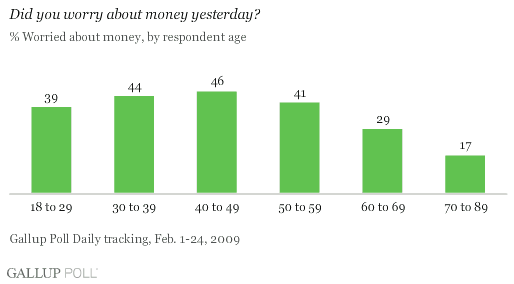
Each day, ÆéûÜǨû§Poll Daily tracking asks Americans if they worried about money "yesterday." On average, well under half say they did. (Worry is higher during the week and lower on weekends.)
Gallup's averaged just 32% worried in January 2008, when ÆéûÜǨû§began tracking it. The percentage who worried grew gradually through August, jumped in September, and by October was at 43%, 11 points above its early 2008 average. Worry dropped slightly in November. In January and so far in February of this year, worry is down slightly more, to 37%. This is still higher than its level in January and February of last year, but is certainly below last fall's peak.
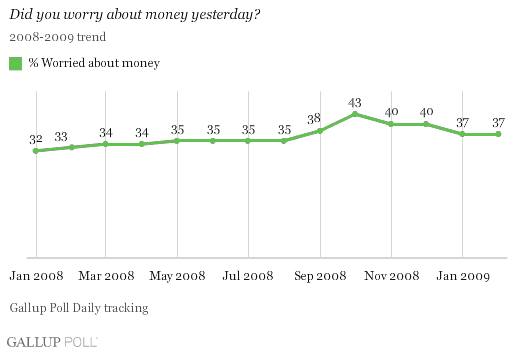
One might think that worry would be higher among older Americans, given recent publicity about the plight of older Americans who are forced to make do in situations in which their retirement incomes (and overall wealth) may be dropping. One recent New York Times article, for example, quoted Alicia Munnell, director of the Center for Retirement Research at Boston College, as saying: "There's a terrified older population out there."
But Gallup's analysis of Feb. 1-24 tracking data, involving more than 11,000 interviews, shows conclusively that this is not the case. Worry about money begins to drop off at age 50 and continues to drop thereafter. (Analysis shows that the current February findings reflect the same patterns evident during 2008.)
Specifically, worry about money in these February data advances slightly from the 18- to 29-year-old age group -- 39% of whom worried about money "yesterday" -- through the 40 to 49 age group, where it peaks at 46%. From age 50 on, however, worry decreases steadily, reaching a low of only 17% among those 70 to 89.
Employment Status
Older Americans are less likely to be employed than those who are younger and, therefore, on average, have lower incomes. Being employed and having a higher income are both associated with lower levels of worry. Thus, the finding that older Americans worry less about money occurs despite the fact that this older population group has lower average incomes and lower employment levels.
The accompanying graph shows that the financial concerns of those not working are particularly high in the middle-aged years relative to those who are employed. By ages 60 to 69, the difference by employment is negligible. But in general, the decline in worry among older Americans occurs regardless of employment status.
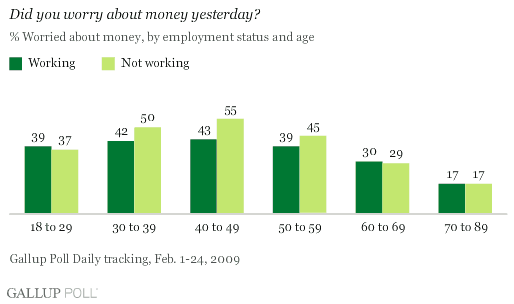
Income
The general relationship between income and worry is in the expected direction. Regardless of age group, those who make at least $60,000 a year are less likely to worry about money than are those making less than $60,000 a year. This gap by income persists even among those in the 70-and-older age category. (The worry gap by income is largest among those 40 to 59.)
All in all, the data show that age appears to have an independent effect on financial worry regardless of financial status.
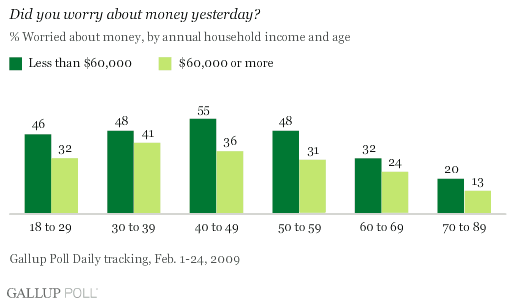
Gender
Women are generally at least slightly more likely than men to say they worried about money, with the exception of the 30 to 39 age group, in which men and women are about equally likely to say this. The gender gap is largest among those 40 to 49. Diminished financial worry among older Americans occurs across both genders; yet even among the oldest Americans in the sample, women are slightly more likely than men to be worried.
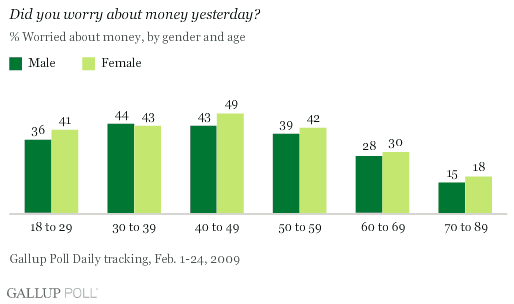
Bottom Line
Americans' daily worry about money declines steadily after age 50, and this relationship between worry and age occurs regardless of work status, income, or gender.
Survey Methods
Results are based on telephone interviews with 11,361 national adults, aged 18 and older, conducted Feb. 1-24, 2009, as part of ÆéûÜǨû§Poll Daily tracking. For results based on the total sample of national adults, one can say with 95% confidence that the maximum margin of sampling error is ôÝ2 percentage points.
Interviews are conducted with respondents on land-line telephones (for respondents with a land-line telephone) and cellular phones (for respondents who are cell-phone only).
In addition to sampling error, question wording and practical difficulties in conducting surveys can introduce error or bias into the findings of public opinion polls.
